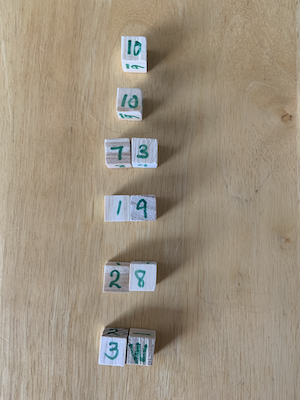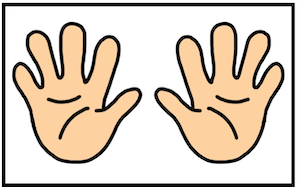|
Addition is not easy for all students. Even the basic facts are difficult for some kids to remember. It is important that we teach several strategies so that children can find ones that will work for them. Today, I am going to focus on making ten. This is a very useful strategy to teach, because it can be used when more difficult addition questions need to be solved. I am a firm believer in starting with concrete, hands on activities so that kids can see and practice the concepts being presented before being handed worksheets or other abstract materials. Here are a couple of my favorite activities. Making tens with dice Using dice to make ten is a great way to see the numbers and make connections with them. In this first activity, I use the dice from a game. There are 5 dice with the numbers 1,2,3,4, and 2 Ws. There are 5 dice with the numbers 5,6,7,8,9,and 10 on them. The goal is to find 2 dice that go together to make 10. I usually do this with pairs. Each person gets 3 rolls. On the third roll, a W may be used as a wild card to make 10. It can be fun to see who gets more 10s on their turn. In order to allow several groups of children to play at once, I bought some wooden cubes from the dollar store and I labelled them to match the dice from the game. It is amazing how quickly kids move from having to count fingers to figure out which numbers go together to be able to automatically see the corresponding numbers. When they get really good at making tens with the six sided dice, I give them 10 sided dice. The object is the same, but this time there are no wild cards. They get really excited about having the fancy dice to work with. Making tens with ten frames Ten frames are another great tool for helping kids make ten. They are set up with two groups of five so that kids can start to see combinations to make ten quickly. Ten frame cards are also great for playing different types of games to help reinforce quick recognition of numbers that go together to make ten. I created ten frames in multiple sizes to use with my tutoring students. The large ones can work with big groups when talking about making tens. I also like to do team games where they try to see who can name the number first. It is a big motivator for some kids. (I try to pair kids up that are of similar levels so they don't get easily discouraged.) The medium sized ones are great for working in pairs. They can be used for matching games or for making tens. They are played like the old card game "Snap". The one who sees the ten first gets all the cards played. The game continues until all the cards are gone or the time is up. The little ones are great for travelling. They fit into a pocket and can be used for a quick game while on the road. If you are lucky, you can find containers that look like 10 frames. If you can't find any, you can make them by cutting off egg cartons. Using small objects (bingo chips, mini erasers, buttons, etc.) the children can show numbers and then tell you what they need to make ten. For example, if they have 8 buttons in the container, they need 2 to make 10. Another thing I like about them is that they match up with the ten we carry with us all the time - our hands. When you ask a child to show you 7 they usually hold up one hand with 5 fingers and one hand with 2 fingers. These are just a couple of different ways to use manipulatives for making tens. There are many other ways. Base ten blocks and unifix cubes are a couple that come to mind. Just let your imagination help to inspire you and you will be amazed at what you can use. I hope these suggestions help. Related Posts
Comments are closed.
|
About Me Charlene Sequeira
I am a wife, mother of 4, grandmother of 9, and a retired primary and music teacher. I love working with kids and continue to volunteer at school and teach ukulele. Categories
All
|



















 RSS Feed
RSS Feed